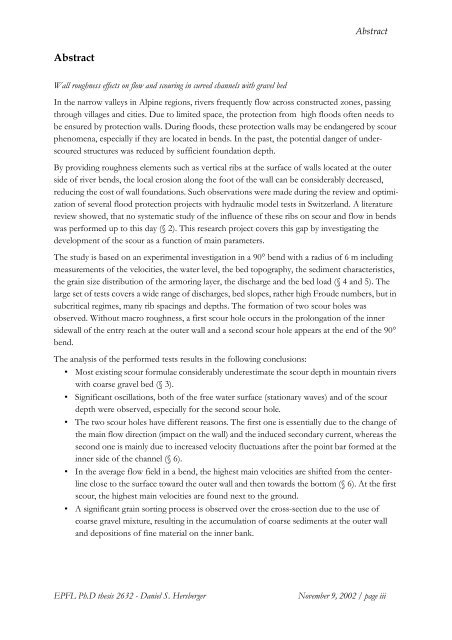pdf, 12 MiB - Infoscience - EPFL
pdf, 12 MiB - Infoscience - EPFL
pdf, 12 MiB - Infoscience - EPFL
Create successful ePaper yourself
Turn your PDF publications into a flip-book with our unique Google optimized e-Paper software.
Abstract<br />
Abstract<br />
Wall roughness effects on flow and scouring in curved channels with gravel bed<br />
In the narrow valleys in Alpine regions, rivers frequently flow across constructed zones, passing<br />
through villages and cities. Due to limited space, the protection from high floods often needs to<br />
be ensured by protection walls. During floods, these protection walls may be endangered by scour<br />
phenomena, especially if they are located in bends. In the past, the potential danger of underscoured<br />
structures was reduced by sufficient foundation depth.<br />
By providing roughness elements such as vertical ribs at the surface of walls located at the outer<br />
side of river bends, the local erosion along the foot of the wall can be considerably decreased,<br />
reducing the cost of wall foundations. Such observations were made during the review and optimization<br />
of several flood protection projects with hydraulic model tests in Switzerland. A literature<br />
review showed, that no systematic study of the influence of these ribs on scour and flow in bends<br />
was performed up to this day (§ 2). This research project covers this gap by investigating the<br />
development of the scour as a function of main parameters.<br />
The study is based on an experimental investigation in a 90° bend with a radius of 6 m including<br />
measurements of the velocities, the water level, the bed topography, the sediment characteristics,<br />
the grain size distribution of the armoring layer, the discharge and the bed load (§ 4 and 5). The<br />
large set of tests covers a wide range of discharges, bed slopes, rather high Froude numbers, but in<br />
subcritical regimes, many rib spacings and depths. The formation of two scour holes was<br />
observed. Without macro roughness, a first scour hole occurs in the prolongation of the inner<br />
sidewall of the entry reach at the outer wall and a second scour hole appears at the end of the 90°<br />
bend.<br />
The analysis of the performed tests results in the following conclusions:<br />
• Most existing scour formulae considerably underestimate the scour depth in mountain rivers<br />
with coarse gravel bed (§ 3).<br />
• Significant oscillations, both of the free water surface (stationary waves) and of the scour<br />
depth were observed, especially for the second scour hole.<br />
• The two scour holes have different reasons. The first one is essentially due to the change of<br />
the main flow direction (impact on the wall) and the induced secondary current, whereas the<br />
second one is mainly due to increased velocity fluctuations after the point bar formed at the<br />
inner side of the channel (§ 6).<br />
• In the average flow field in a bend, the highest main velocities are shifted from the centerline<br />
close to the surface toward the outer wall and then towards the bottom (§ 6). At the first<br />
scour, the highest main velocities are found next to the ground.<br />
• A significant grain sorting process is observed over the cross-section due to the use of<br />
coarse gravel mixture, resulting in the accumulation of coarse sediments at the outer wall<br />
and depositions of fine material on the inner bank.<br />
<strong>EPFL</strong> Ph.D thesis 2632 - Daniel S. Hersberger<br />
November 9, 2002 / page iii
















